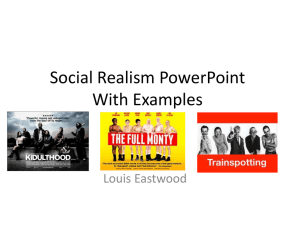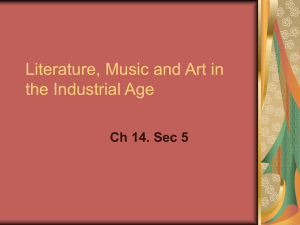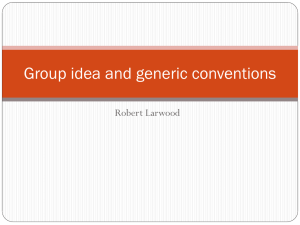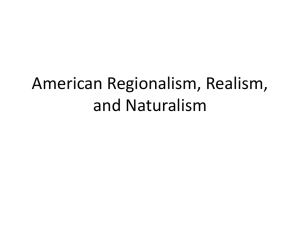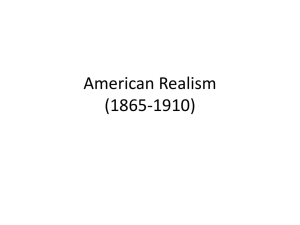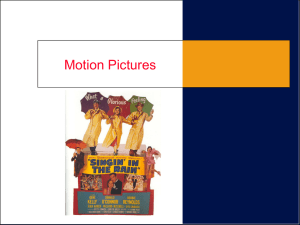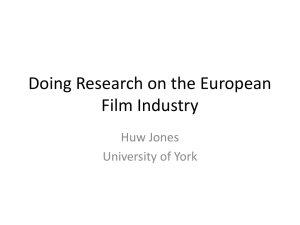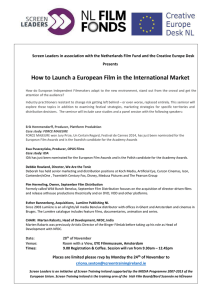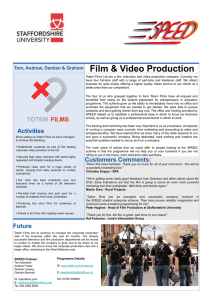Social Realism Powerpoint
advertisement
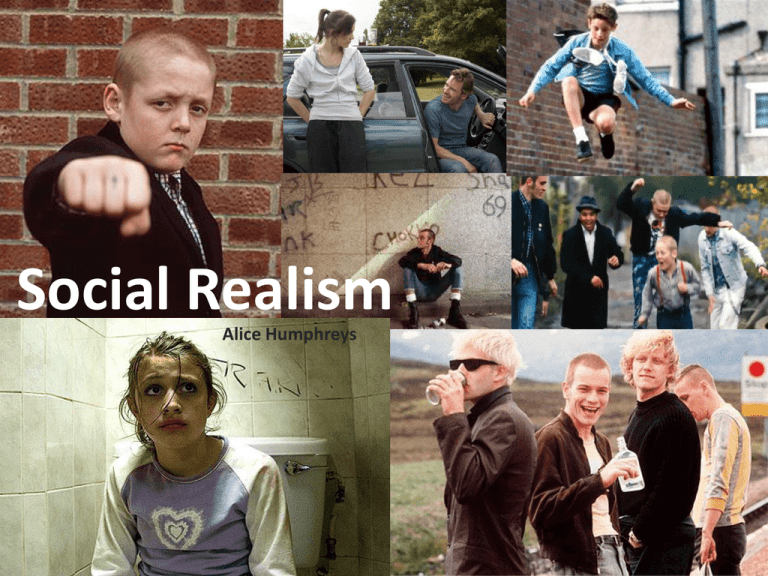
Social Realism Alice Humphreys Setting, characters, generic conventionsOne of the main aims of social realism films is to depict realistic and everyday situations, as the messages that social realism films carry, are often to protest about, or reveal social and racial injustice, economic hardship; through unvarnished pictures of life’s struggle; often depicting working class activities as heroic. For social realism to show the social struggle, injustice of society, tarnished morals and standards of living, a serious, realistic, and direct atmosphere must be created for the audience to connect with the characters, emotion and message, and not get distracted by special effects, ‘over the top’ music, over complicated structure, etc. Natural, dull, un-forced lighting is often used continuously and throughout to focus fully on the character/location. Close-ups and extreme close ups are frequently used to engage the audience to the characters and fully see their emotions and reactions. Using close up shots will build a sense of relationship and familiarity with the audience and the character, encouraging sympathy and empathy, pulling in the audience’s attention and focus. In many contemporary social realism films, such as ‘This is England’ directed by Shane Meadows, montages of locations or characters, without speech, will be shown at points to fully create a sense of location, and time. Location shots are often un-dramatised and simple, showing gritty and realistic places that are often thought to be related with lower and working classes. Characters represented in social realism films are often working class, either seen as heroic, or or if the other extreme; upper/middle class characters, who usually represent greed and selfishness, or naivety. Examples of social realism films from 1961 to 2009 • A Taste of Honey, Directed by Tony Richardson- 1961 • A Kind of Loving, Directed by John Schlesinger- 1962 • Kes, directed by Ken Loach, 1969 • Trainspotting, Directed by Danny Boyle1996 • East is East, directed by Damien O’Donnel- 1999 • Billy Elliot, directed by Stephen Daldry2000 • Bend it Like Beckham, directed by Gurinda Chadha- 2002 • This is England, Directed by Shane Meadows- 2006 • London to Brighton, Directed by Paul Andrew williams- 2006 • Fish Tank, Directed by Andrea Arnold2009 Why are Social Realism Films so Popular? Rather than fictional, exaggerated, unbelievable and ‘over the top’ films, social realism films have the factor of ‘hitting home’ with social issues and gritty realism and people and audiences truly can connect to. Socially realistic films deal with these issues and present the characters in an unsensored, un-masked and ‘in your face’ way, that make audiences deal with racial and social issues, and economic hardships that many want to hide away from, giving these films a feel of importance, bravery and honesty, that often shock audiences as well as educate them. Comparing an old Social realism Trailer, with a New one.. Kes, Directed By Ken Loach, 1969 http://www.youtube.com/watch?v=HRYvUpsrqmg Fish tank, directed by Andrea Arnold, 2009 http://www.youtube.com/watch?v=ZLToqiVSRH0 Comparing an old Social realism Trailer, with a New one.. Even though ‘Kes’ was released 40 years before ‘Fish Tank’, similar generic conventions are used, such as, simple and obvious camera angles and natural lighting to give a more realistic and natural atmosphere, a montage of unpleasant or taboo situations (such as a child being hit, getting into a fight, etc) that the main character comes across; showing the world of the film in an unvarnished, ‘real life’ way, etc. The trailers are also similar in the way that they both use simple and slow credits and intertitles, that offer information about cast, director , ratings and review quotes. The two trailers differentiate in ways mainly due to the time period in which they were produced. Things like the quality of the images, and the language and accent. Examples of Social Realism Films http://www.youtube.com/watch?v=a 7BFZqQ4ruA Fish Tank was Directed by Andre Arnold and was released in 2009 Just from watching the trailer it is easy to see the use of social realism’s most common generic conventions. The film allows you to peer, is a realistic and unvarnished way, into the world of a working class girl, living in a council estate flat, and her struggles with family life, living conditions and trying to follow her passion. Fish tank was quoted as “The most honoured British film of the year” and won 3 European and 8 British film award nominations, including best actress, best director and best film. On the next slide there are visual examples of how in camera composition, lighting, characters and setting is used in the film, and how it fits in clearly to the Social Realism Genre. http://www.youtube.com/watch?v=Sl6O7sad9hI Trainspotting is a 1996 Social realism/drama film directed by Danny Boyle, based on the novel of the same name by Irvine Welsh. The movie follows a group of heroin addicts in a late 1980s economically depressed area of Edinburgh and their passage through life. The film fits into the Social Realism theme through its use of common generic conventions, such as characters, lighting, music and the way it shows you in an un masked way, the realistic life style and social world of a group of heroin addicts, and questions society’s idea of ‘leading a normal life’, especially in the ending speech: “So why did I do it? I could offer a million answers, all false. The truth is that I'm a bad person, but that's going to change, I'm going to change. This is the last of this sort of thing. I'm cleaning up and I'm moving on, going straight and choosing life. I'm looking forward to it already. I'm going to be just like you: the job, the family, the fucking big television, the washing machine, the car, the compact disc and electrical tin opener, good health, low cholesterol, dental insurance, mor tgage, starter home, leisurewear, luggage, three-piece suite, DIY, game shows, junk food, children, walks in the park, nine to five, good at golf, washing the car, choice of sweaters, family Christmas, indexed pension, tax exemption, clearing the gutters, getting by, looking ahead, to the day you die.” On the next slide you will find some visual examples of how the film has used social realism’s generic conventions, such as camera angles, lighting and setting. The Unloved The directorial debut from Oscar-nominated actress Samantha Morton, this powerful drama about a young girl growing up in a children's home provides an intimate child'seye view of the UK's care system. Samantha Morton's directorial debut is a powerful single drama about a young girl growing up in a children's home. Working alongside acclaimed writer Tony Grisoni, Morton has created a fictional script that gives an honest and intimate child's-eye view of the care system in the UK. Filmed in Morton's hometown of Nottingham, the two young leads - Molly Windsor as Lucy, and Lauren Socha as Lauren were cast through a series of open auditions held across Nottingham schools, drama groups and at The Television Workshop, which Morton herself attended aged 12. Head of Channel 4 drama, Liza Marshall, says: 'We at Channel 4 are very excited to be supporting Sam in her first directorial venture. This is a story very close to her heart, and her empathy and understanding of children in care should make for an exceptional film. http://www.channel4.com/programmes/the-unloved/episodeguide/series-1/episode-1 The Telegraph's Michael Deacon gave the film a positive review describing it as 'Riveting' and 'Powerful from start to finish'; On the other hand, he stated the film was 'Stomach churning' and 'Hard to watch'; however to his surprise he couldn't take his eyes off the film and praised Morton on creating an 'Intense' and 'Vivid' dramatic film. Filmed entirely on location in Nottingham, the film cost £1.5million to make. The title of the film was inspired by a newspaper article Morton had read about children in the care system .Morton spent time in other cities such as Newcastle, Glasgow and around London although decided it was best to make a film about the world she knew and grew up in. Originally wanting to set the film in 1989, Morton later decided against it as she wanted to focus on the struggles of the present day and not want audiences to write it off as a historical piece. The scene where Lucy witnesses the rape of Lauren didn't have Windsor present at the time as it was deemed inappropriate; her involvement in the scene was filmed separately and added later. Blurred, awkward angles, to create the sense of confusion and un-understanding that the child feels. •Long, empty, calm and simple shots to contrast with the quick paced edited shots, that create the sense of boredom and loss. •Smooth yet handheld camera movements, seems less staged and more realistic •Completely realistic lighting; fits in with the realism theme On the next slide you will find some visual examples of how the film has used social realism’s generic conventions, such as camera angles, lighting and setting.
